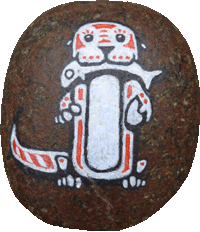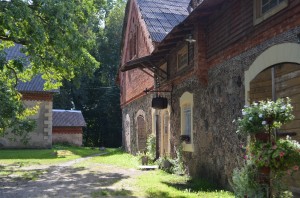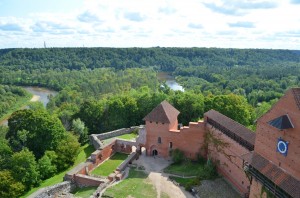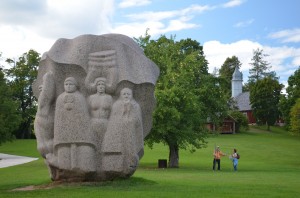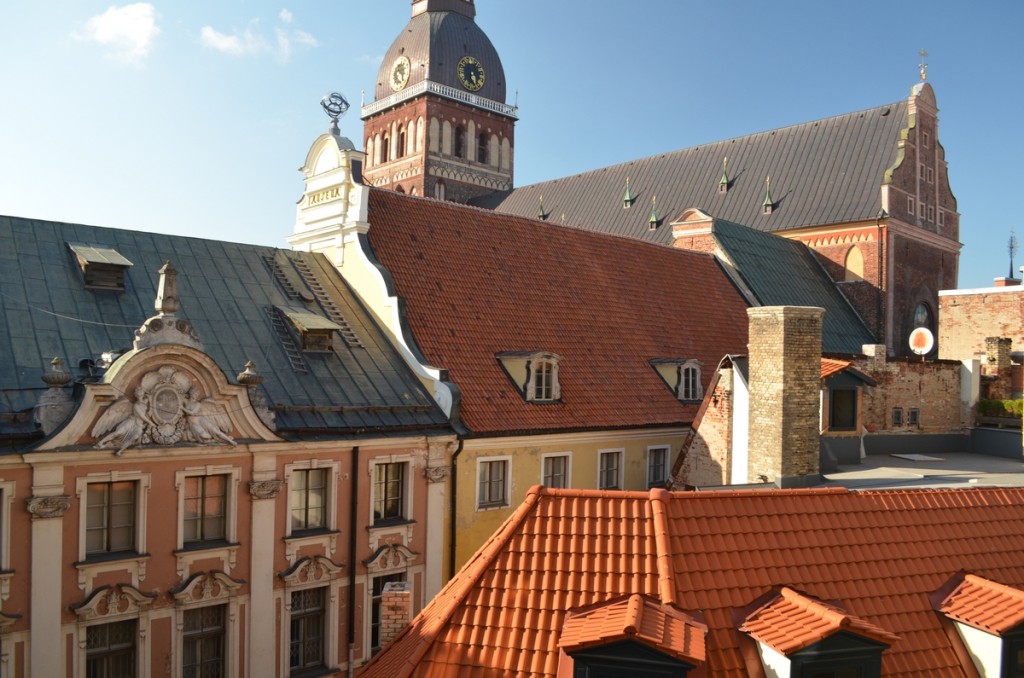So of course we visited Sigulda on the day of a massive nationwide cycling event to be held in the little town. Which meant that after visiting the castle and Krimulda, it then took fifteen minutes to get out of the car park as the whole race cycled past, and then we had to take a thirty minute – thirty minute! – detour to get to Turaida castle, which is actually visible across the valley from Sigulda!
Sigulda castle is a small patch of very restored medieval ruins, not much to see. What I liked rather more was taking the cable car across the wide Gauja valley (it’s a 1km cable!) to the 19th century sanitarium and village of Krimulda. There’s really nothing much to see, just a peaceful collection of buildings that look pleasantly crumbly on a sunny morning in early autumn. Very easy to imagine your way back into the past here. Would make a great set for a costume drama.Back across the valley and we had our 30 minute drive back-back across the valley again to Turaida. The castle here is a big red-brick affair. To English eyes this seems all wrong for a medieval castle, which ought to be built from huge chunks of stone, but for whatever reason (lack of rock, I guess!) most of the medieval castles in the Baltic were built in red brick. Given the walls are still six foot thick, a lot of red brick. Of course, a lot of the bricks making up Turaida castle today are relatively new, as it has been heavily restored. And why not?
I’ve bought into the British approach to heritage for a long time; restore medieval structures just enough to stabilise them, but essentially keep them “as found”. And yet, how arbitrary is that? These buildings have been evolving, building up and crumbling down, since they were first built. Why should a visitor in the 22nd century, say, have to see the building as it existed in the 1980’s? What’s so special about “now” that it should be the state we choose to preserve? Why not bring it back to the state in which it was last in use, so that at least it becomes easier to understand the purpose of the place and what it would have been like to live and work in it?I’m only asking philosophically. I’ve grown up with British castles, so I’m always going to love a picturesque ruin more than a pristine restoration.
In the same “museum park” as Turaida castle is a broad and grassy ridge dotted with dozens of handsome, rounded granite statues representing Latvian folk tales. This was lovely.We wound up in Riga at the end of the day, in a very splendid hotel right slap-bang in the middle of the old town. Indeed, there’s a lovely view of the cathedral roof from our bedroom window. They have the most hilarious parking regulation I’ve ever come across here. We asked the receptionist where we could park, as we had just pulled up outside the hotel. She directed us to park on the corner, just over the road. That’s right. On the corner. If we parked on a straight part of the road the police would be unhappy. We just needed to park exactly on the corner. She directed me, in fact, to make sure I was suitably aligned. On the corner. What the?!? But what can I say: the car sat there for the next 36 hours with no problem at all.
After a pleasant walk around the old town (less medieval chocolate-box than Tallinn) we wound up at a fine dining restaurant called “3 parvenu” where we dined fine. It was really kinda over-priced for the level of cooking, but a good meal. Charming old gent serenaded diners with an accordian, then begged for money, as you do.
Related Images:
